SUMMARY
This is AI generated summarization, which may have errors. For context, always refer to the full article.

Editor’s Note: This is an updated version of a paper submitted by the author for the course “Christianity and Religious Diversity” in September 2019, as part of his masteral coursework at the S. Rajaratnam School of International Studies at Nanyang Technological University, Singapore. Rappler is publishing this as part of its series of articles for the Chinese New Year.
MANILA, Philippines – Years after Jesuit priest Matteo Ricci arrived in China to spread Christianity, a similar desire to evangelize the Middle Kingdom was blooming in the Philippines.
It was the late 1500s, and the Philippines was a Spanish colony. The Bishop of Manila, Domingo Salazar, wrote to King Philip II of Spain on June 24, 1590.
The Bishop of Manila told the King that he went to the Philippines precisely because it was a jumpoff point to China. The Bishop of Manila wrote: “I have long wanted to attempt the conversion of China. I came to these islands primarily for that reason knowing that they were very near China and that many Chinese lived here.”
Chinese studies scholars Aristotle Dy and Teresita Ang-See narrated these events in “Syncretism as Religious Identity,” a chapter in the book After Migration and Religious Affiliation. According to Dy and Ang-See, Salazar also told King Philip II that some Chinese traders belonged to the Christian faith, “but most were ‘pagans.’” Based on contemporary research, these “pagans” were practitioners of Chinese Religion, a syncretic system of belief that includes Buddhism, Confucianism, and Daoism.
The Bishop of Manila eventually won the trust of these Chinese merchants through his goodwill, wrote Dy and Ang-See.
A daring suggestion, however, came from the Jesuit priest Alonso Sanchez, who had arrived in Manila at the same time as Salazar in the late 1500s.
Sanchez’s proposal: to send “an armed expedition from the Philippines to China with the object of compelling the Chinese government to permit the entry of missionaries into China, and of providing the missionaries with an armed escort to ensure their safety while preaching Christianity to the Chinese,” recounted the Jesuit historian Horacio de la Costa in his book, The Jesuits in the Philippines.
Sanchez’s proposal did not prosper, but still the Jesuits in the Philippines tended to the Chinese in Manila – to prepare for missions in China. Other religious orders had the same plan.
Thus began the encounter of Catholic Christianity and Chinese Religion in the Philippines. It was a meeting of two religious traditions that has been marked by goodwill, and also by disagreements due to incompatible religious practices. One of their points of disagreement was the Chinese practice of venerating ancestors, an issue also faced by Ricci in China.
Such difficulties between the two religious traditions have persisted through the centuries. To this day, Chinese Religion poses a challenge to Catholic authorities in predominantly Catholic Philippines, mirroring the obstacles faced by Ricci when he tried to evangelize China.
We see these dynamics at play in celebrations of the Chinese New Year in the Philippines, for example, when Filipino-Chinese families that profess the Catholic faith continue their age-old practices of visiting Buddhist temples to wish for a prosperous year and to venerate their departed ancestors.
Our Rappler team witnessed this in the evening of Friday, February 9, the eve of the Chinese New Year, at the iconic Seng Guan Temple in Manila. One of the people we interviewed was Marjorie Jacob, 44, a Catholic, but who visited Seng Guan on Friday to honor her deceased mother. Shey Jasmine Tan, a 19-year-old Catholic, explained that “you can practice your culture and your faith at the same time.”
Watch our video report at Seng Guan Temple below.

In Cebu, Rappler’s Visayas reporter John Sitchon wrote about how the Filipino-Chinese keep statues of the Buddha and the Santo Niño (Child Jesus) side by side in their home altars. Descendants of these Cebu clans as well as historians “believe that this tradition is a ‘marker of unity’ and compelling evidence of the melding of beliefs that emerged during the 16th century,” Sitchon explained in his Rappler feature on Saturday, February 10.
Understanding Chinese faith
But what, in the first place, is Chinese Religion?
Chinese Religion is a term coined by scholars for the syncretic religious tradition espoused by any Chinese. Syncretism refers to “the simultaneous practice of elements from different religious traditions,” wrote Dy and Ang-See.
Chinese Religion, therefore, refers to “the complex of Chinese religious beliefs and practices,” including Chinese Buddhism, Confucianism, Daoism, and Chinese popular religion, according to anthropology professor Tan Chee-Beng. Ang-See and Dy – who is also a Jesuit priest – explained in their book chapter that “the syncretic way of thinking is a key characteristic of Chinese Religion.”
In the Philippines, Chinese Religion and Roman Catholicism had their first interactions decades after Spain colonized the country and imposed Christianity on the natives.
Spanish colonial rule lasted for 377 years, and the Catholic Church grew into a powerful force in the country. Today, nearly 8 out of 10 Filipinos belong to the Catholic Church, and the Philippines remains the biggest predominantly Catholic country in Asia.
As it was in the 16th century, practitioners of Chinese Religion remain a small minority. There are no official government statistics on adherents of Chinese Religion. The government’s 2020 census, however, notes that there are only 39,150 Buddhists in the Philippines, or around 0.03% of the Philippines’ population of 108.67 million.
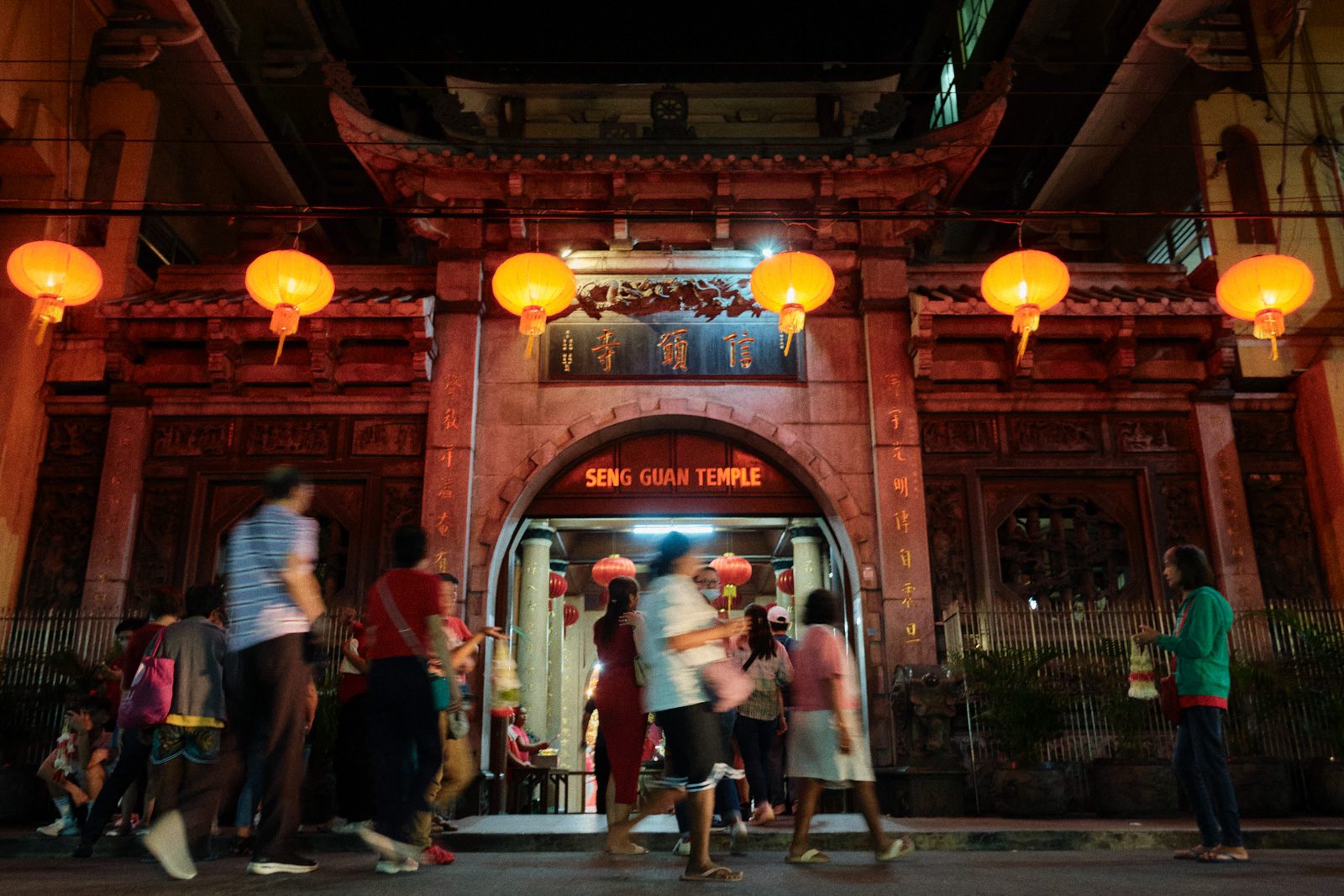
For centuries, Chinese Religion in the Philippines has interacted with Catholic Christianity from a place of weakness in the face of a powerful church.
Biggest disagreement: Venerating ancestors
While thousands of Chinese converted to Catholicism during the Spanish colonial rule, however, the converts never completely left Chinese Religion. The Chinese, after all, were used to a syncretic system of belief. This syncretism was, and still is, a source of disagreements between Chinese Religion and Catholic Christianity in the Philippines.
The Chinese tradition of venerating ancestors was the biggest point of disagreement between the two religious traditions. In his book Building a Bridge, Dy writes that Catholicism, during the Spanish colonial rule in the Philippines, prohibited the veneration of ancestors. “This undoubtedly caused many Chinese to stay away from a religion that asked them to forsake their parents.”
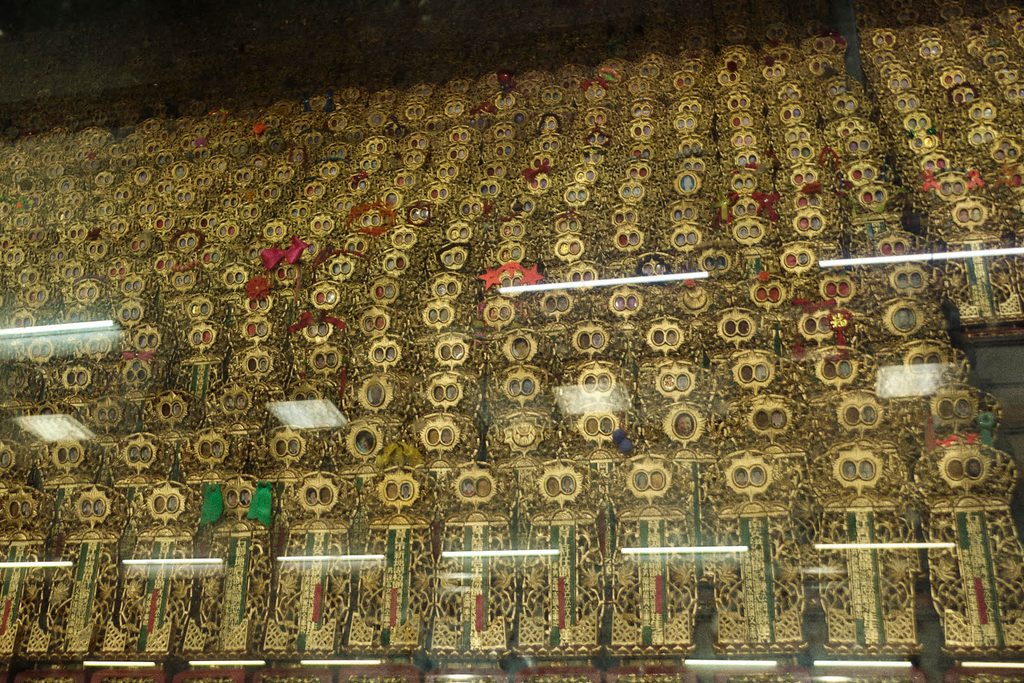
As for the thousands of Chinese who converted to Catholicism, the caveat was that they continued to practice Chinese beliefs, especially in honoring the dead. In their book about Chinese burial grounds in Manila, Ang-See and Richard Chu note that according to studies, Spanish missionaries “often complained about the sincerity of Chinese converts” because they persisted in practicing non-Christian traditions.
Ang-See and Chu point out that the Catholic Church “was troubled by the observance of Buddhist or non-Christian rituals in the cemetery.” “Hence, the Catholic Church made valiant efforts to make sure that its converts were not ‘contaminated’ by the ‘infidels’ by keeping the two separate, not only in life but also in death.”
In fact, in 1877, the Governor General of the Philippines reminded a gobernadorcillo, or the town mayor, “that Christians and ‘heathens’ should be buried separately.”
Other points of disagreement between Chinese Religion and Catholic Christianity involve icons or rituals to honor Buddhist gods and goddesses, and Catholic saints. Many adherents of Chinese Religion display and worship icons from different religions side by side. They also use the styles of Chinese ritual to worship non-Chinese deities, and they identify Chinese deities with Catholic ones.
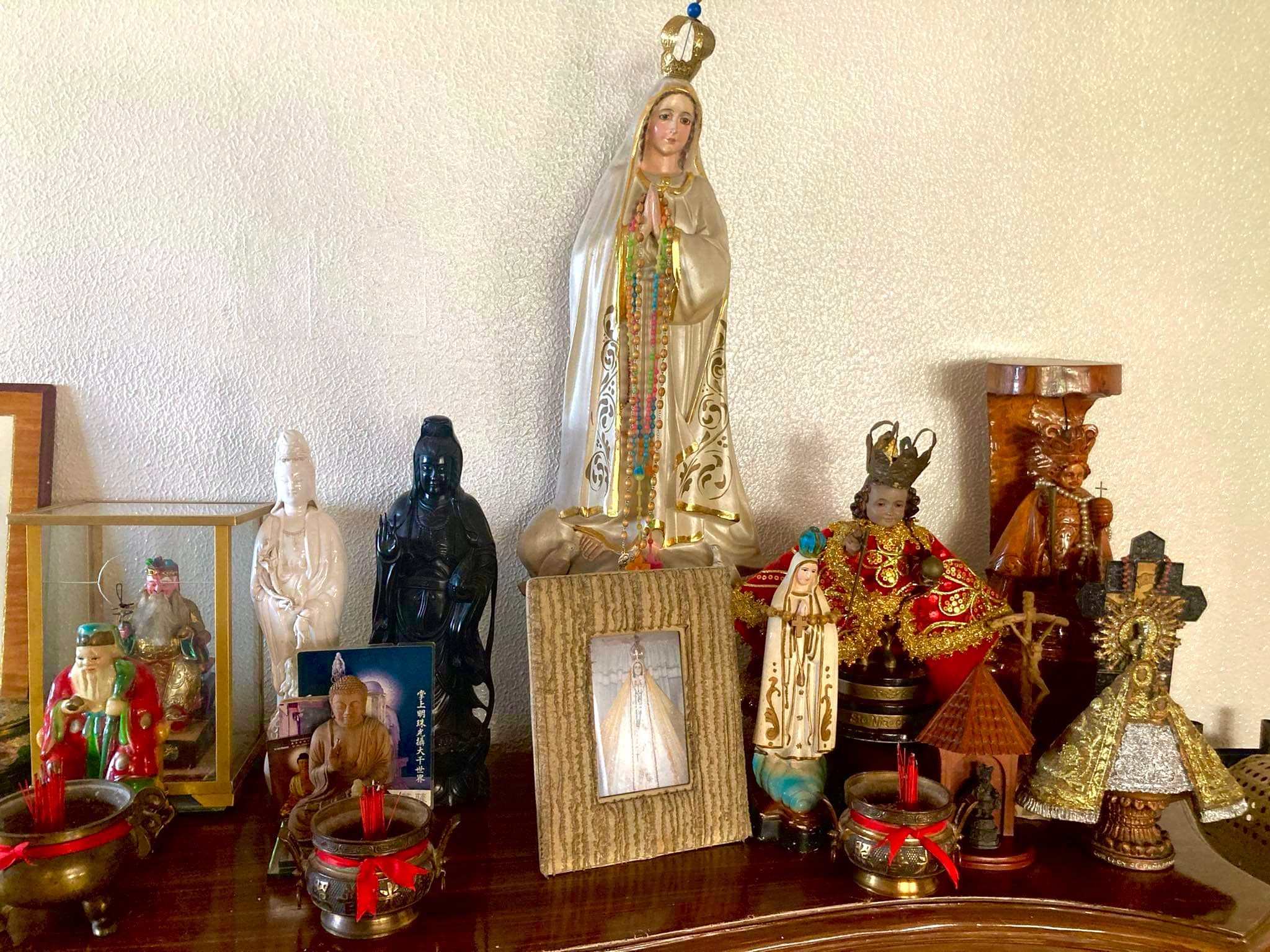
Clashes and mixtures
These points of disagreement between Chinese Religion and Catholic Christianity stem from theological and practical reasons.
First, Chinese religious beliefs and Catholic doctrines are incompatible in many areas. Adherents of Chinese Religion, for example, believe in reincarnation, while Catholics believe that each soul only has one chance to live on earth. Catholics worship only one God, but those who subscribe to Chinese Religion tend to worship many gods
Second, adherents of Chinese Religion believe it is more practical to subscribe to many gods in different faiths because it is “safer to believe than not to believe.” Ang-See and Dy write that Chinese Filipinos, business-minded as they are, seek to be practical.
They explain: “The practical Chinese mind seeks to unite rather than divide, to include rather than exclude. In religion, this means believing that all religions are good because they all teach people to be good and to do good. Doctrinal differences can be overlooked in favor of the similar ethical demands made by all religions. Therefore, there is nothing wrong with embracing more than one faith.”
Richard Chu, as cited by Juliet Lee Uytanlet in The Hybrid Tsinoys, believes that the Chinese in the Philippines turned to Roman Catholicism with “their cosmological understanding that there were many gods in this world.” This means that to be prosperous, the Chinese “need to appease the new ghosts or new gods by worshiping them, burning incense, giving them gifts, and establishing relationships.”
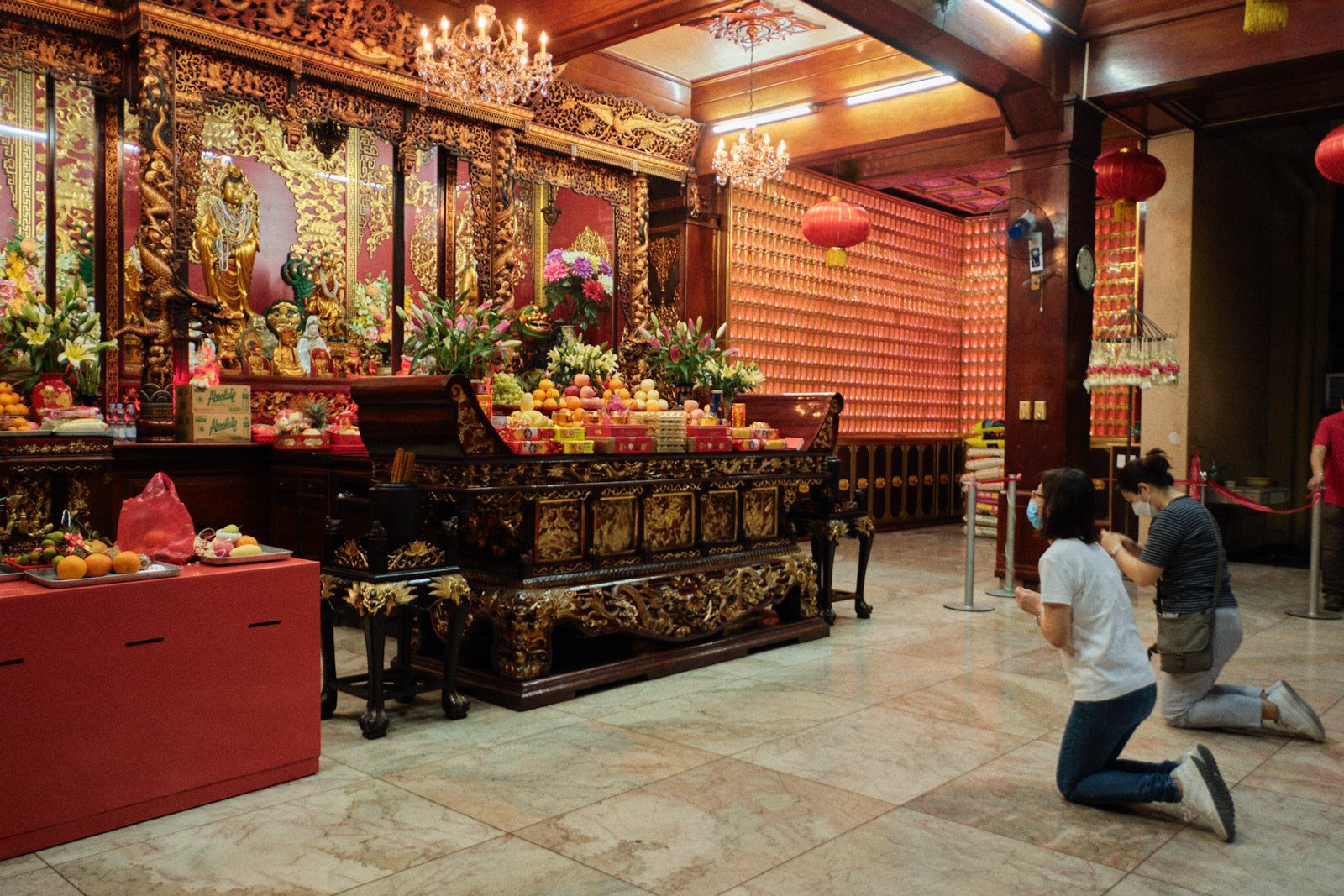
Uytanlet agrees with Chu “that the Chinese turning to Christianity was actually adding new gods instead of replacement of their former gods since their cosmological understanding is that there are many gods or spirits.” Therefore, in the eyes of Chinese converts to Christianity, “the Christian God then is the Supreme Being yet there are also many lesser gods.”
For Uytanlet, this helps explain “why Buddhism blended well with Daoism and eventually the Christian faith.”
Different contexts, different approaches
The disagreements between Chinese Religion and Catholic Christianity in the Philippines mirrored the issues faced by Jesuit priest Matteo Ricci when he started evangelizing in China on August 7, 1582. Both Ricci and the Philippine missions grappled with the syncretism of the Chinese and their veneration of ancestors.
Certainly, Ricci and the Catholic missionaries in the Philippines lived in different contexts. Ricci entered China with Christianity as a foreign religion interacting with dominant Chinese beliefs – Confucianism, Buddhism, and Daoism. Ricci was part of the minority. On the other hand, the Catholic missionaries in 16th-century Philippines encountered adherents of Chinese religion at a time when the Spanish ruled the Philippines. The Catholics there had the power.
Different contexts, then, led to different approaches. Ricci and his fellow Jesuits accommodated Chinese culture, to the point of dressing like Buddhist monastics, according to The Cambridge Companion to the Jesuits. They also remained open to and tolerated Chinese values, such as venerating their ancestors.
In a university lecture, Tan Loe Joo explained that the Jesuits justified the elements of ancestor veneration – “incense burning, prostrating oneself, or offering food” – “as mere civic duty than religious observances.”
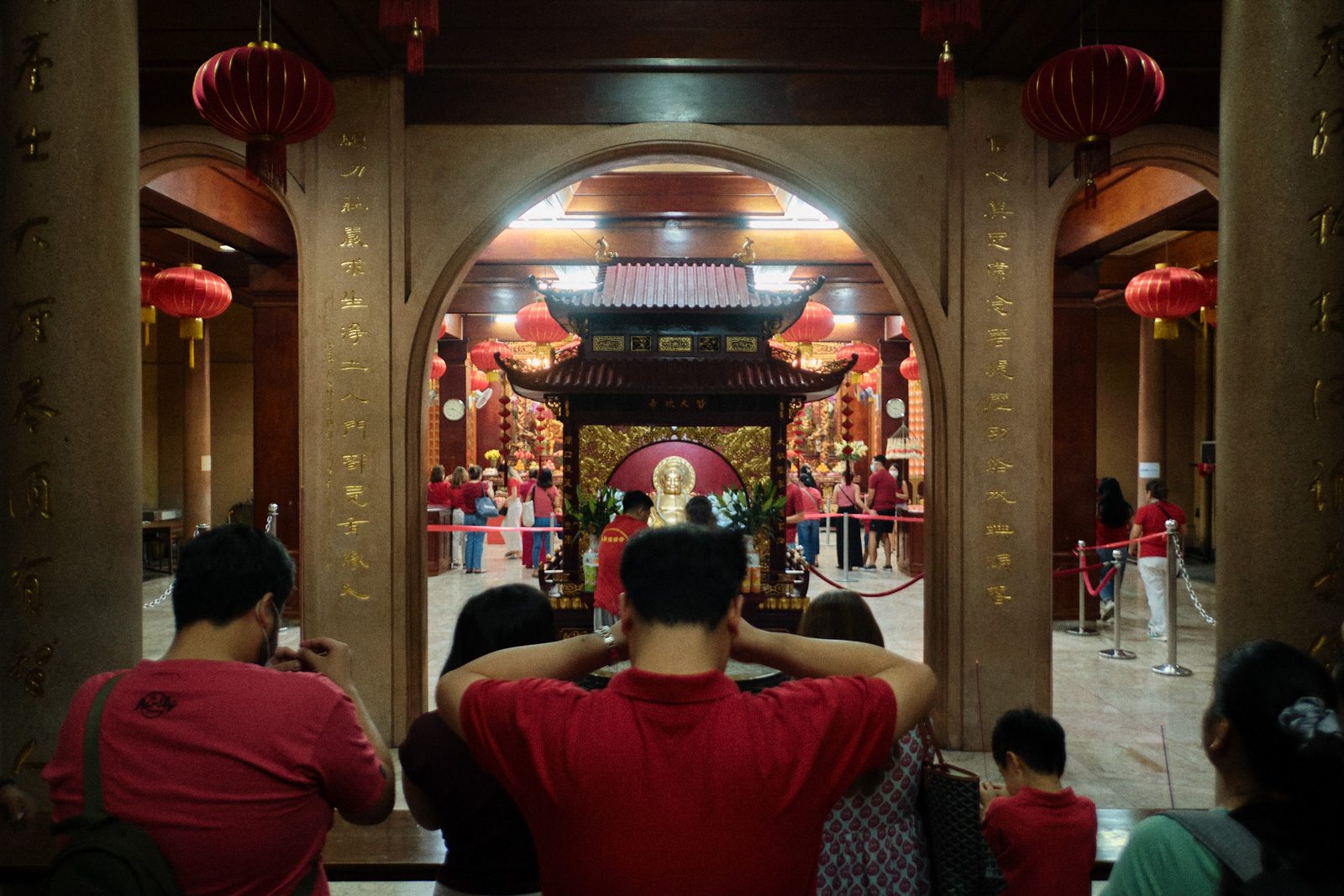
Tan explained that the mendicant priests – the Augustinians, Franciscans, and Dominicans – questioned the Jesuits’ policy toward the Chinese. This is because the mendicant orders “had a more culturally-limited Eurocentric view” of the extent to which Chinese Christians can participate in non-Christian rituals. Eventually, the Vatican intervened, decreeing against Chinese rites in November 1704. This became known as the Rites Controversy.
Like the mendicant priests in the Rites Controversy, the Spanish missionaries in the Philippines employed an approach different from Ricci’s. After all, not only were the Spanish missionaries part of the colonial power. These 16th-century clergymen also came from a Eurocentric context.
Another concept that influenced their worldview was extra Ecclesiam nulla salus (“outside the Church, there is no salvation”), an exclusivist doctrine that went as far back as the 3rd century, but would radically evolve after the Second Vatican Council in the 1960s. (The Second Vatican Council, also known as Vatican II, is a historic gathering of bishops to discuss ways by which the Catholic Church can return to its roots and reform itself in a modern world.)
Thus, to evangelize adherents of Chinese Religion, the Spanish missionaries in the Philippines did not pursue accommodation or tolerance as Ricci did. On the other hand, they employed a hardline approach, as they segregated Muslims and Christians, and even forced them to abandon their “pagan” practices.
From miles away, the Spanish missionaries also viewed Ricci with contempt.
In the Philippines, the Catholic priest Fray Juan Cobo learned of Ricci’s mission in China, “but he considered his efforts to be rather fruitless,” writes Ryan Dominic Crew in his journal article, Pacific Purgatory. Cobo referred to Ricci’s style of wearing the robes of Buddhist monastics and Confucian literati to attract the Chinese. Such a method, said the friar, was getting “considerable suspicion” in Manila. The Spanish missionaries also heard rumors that Ricci’s discreet method “had only won a scant number of converts in the Chinese elite.”
The Spanish missionaries, at times, did adapt their methodologies to local culture in the Philippines, but they believed it was important to do so “from a position of undisguised power.”
What Matteo Ricci can teach us
The experiences of the Spanish missionaries in the Philippines and Matteo Ricci in China demonstrate two models of Christianity encountering other faiths or cultures. In the Philippines under Spanish colonial rule, the Catholic missionaries imposed their faith on the Chinese. In China, as foreign missionaries, Ricci and his fellow Jesuits adapted to Chinese culture.
Today, the model of imposing one’s faith on another is considered a vestige of colonialism. In the Catholic Church, this is seen as part of the exclusivist, pre-Vatican II worldview embodied by the concept of extra Ecclesiam nulla salus. Forcing one’s faith on another culture, as the Spanish did in the Philippines, is considered negative in the contemporary world.
Even Pope Francis condemned proselytism, “by which he means coercive or aggressive missionary techniques.” On the Feast of the Conversion of Saint Paul on January 25, 2015, Francis stated that for evangelization to be effective, “we need to stop being self-enclosed, exclusive, and bent on imposing a uniformity.” He added, “Our shared commitment to proclaiming the Gospel enables us to overcome proselytism and competition in all their forms.”
Francis, the first Jesuit pope, reflects the model used by Ricci and the Jesuits in China – to a certain extent. By adapting to the culture of the Buddhists and Confucianists in China, Ricci avoided, in the words of Francis, “being self-enclosed, exclusive, and bent on imposing a uniformity.”
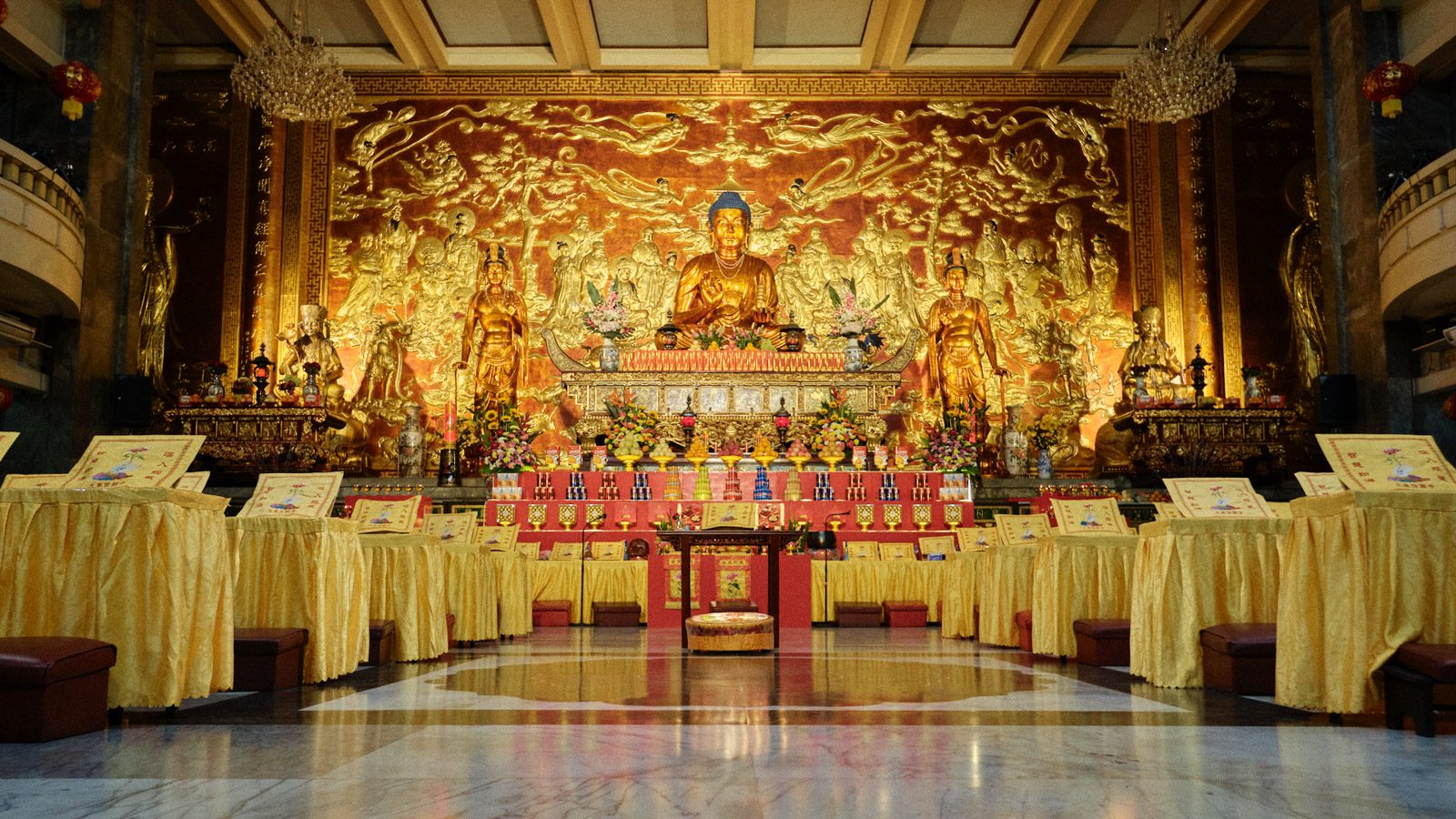
To be sure, Ricci was a product of his own time, and it can be argued that his approach was still exclusivist, in contrast to the inclusive bent of the Catholic Church after Vatican II. Still, Ricci’s method was marked by more openness to a foreign culture, compared to the Spanish in the Philippines.
Ricci’s method is limited, however, by his understanding of Chinese culture.
Ricci made a mistake when he tried to pit Confucianism, Buddhism, and Daoism against each other. Arnold Rowbotham, in his journal article, “The Impact of Confucianism on Seventeenth Century Europe,” said Ricci exalted Confucianism “to the position of a noble philosophical system” while labeling Buddhism and Daoism as “heathen cults.” Ricci, in a way, employed a “divide and conquer” tactic so that Christianity can emerge victorious in the end.
Ricci’s method showed a lack of understanding of the syncretic nature of Chinese Religion, which is explained by modern scholars such as Dy and Ang-See. One cannot simply “divide” the elements of Chinese Religion, because the Chinese understand the cosmos in a syncretic way. Elements of Confucianism, Buddhism, and Daoism can always mix one way or another. Ricci could have benefited from contemporary studies, but again he was a product of his own time.
In any case, the model of Matteo Ricci – to the extent that he knew best – showed the importance of respect. By adapting to Chinese culture rather than imposing, Ricci engaged in dialogue, unlike the Spanish missionaries in the Philippines.
In terms of number of converts, Ricci did not succeed like the Spanish missionaries in colonial Philippines. But Ricci succeeded in exemplifying a sensitive, inculturated way of engaging with other faiths.
Ricci teaches us that respect, which results in dialogue, is key to interreligious encounters in a pluralistic society. – Rappler.com
References:
- Aduarte, Diego. “The History of the Holy Rosary Province: Manila, 1640.” The Philippine Islands, 30: 218-219.
- Chu, Richard T., and Teresita Ang-See. “Toward a History of Chinese Burial Grounds in Manila during the Spanish Colonial Period.” Archipel 92 (2016).
- Crewe, Ryan Dominic. “Pacific Purgatory: Spanish Dominicans, Chinese Sangleys, and the
- Entanglement of Mission and Commerce in Manila, 1580-1620.” Journal of Early Modern History 19 (2015): 350.
- De La Costa, Horacio. The Jesuits in the Philippines 1581-1768. Cambridge: Harvard University
- Press, 1961.
- Dy, Aristotle C. Building a Bridge: Catholic Christianity Meets Chinese-Filipino Culture. Quezon City: Jesuit Communications, 2005.
- Dy, Aristotle C. “Marginal Buddhists: Religion and Identity of a Chinese Minority in the Philippines.” PhD diss. SOAS University of London, 2013.
- Dy, Aristotle C., and Teresita Ang-See. “Syncretism as Religious Identity: Chinese Religious Culture in the Philippines.” In After Migration and Religious Affiliation: Religions, Chinese Identities, and Transnational Networks, edited by Tan Chee-Beng, 103-145. Singapore: World Scientific Publishing Co. Pte. Ltd., 2015.
- Escoto, Salvador P. “Expulsion of the Chinese and Readmission to the Philippines: 1764-1779.” Philippine Studies 47 (1999).
- Felix, Alfonso. The Chinese in the Philippines 1570-1770. Manila: Solidaridad Publishing House, 1966.
- Fernandez, Pablo. “The Apostolate of the Dominicans among the Chinese in the Philippines.”
- Boletin Eclesiastico de Filipinas 435: 182-188.
- Hsia, R. Po-chia. “The True Meaning of the Lord of Heaven.” In A Jesuit in the Forbidden City: Matteo Ricci 1552-1610, edited by R. Po-chia Hsia. Oxford: Oxford University Press, 2010.
- Rowbotham, Arnold H.“The Impact of Confucianism on Seventeenth Century Europe.” The Far Eastern Quarterly Vol. 4, No. 3 (May 1945).
- Tan, Chee-Beng. “Introduction: After Migration and Religious Affiliation.” In After Migration and Religious Affiliation, ed. Tan Chee-Beng (Singapore: World Scientific Publishing Co. Pte. Ltd., 2015), xx.
- Tan, Loe Joo. “Christianity’s Encounters with China.” AS6041: Christianity and Religious Diversity. Class lecture at S. Rajaratnam School of International Studies, Nanyang Technological University, Singapore, August 15, 2019.
- Tan, Loe Joo. “Recent Developments in Christianity,” AS6041: Christianity and Religious Diversity. Class lecture, S. Rajaratnam School of International Studies, Nanyang Technological University, Singapore, August 29, 2019.
- The Cambridge Companion to the Jesuits. Cambridge: Cambridge University Press, 2008.
- Uytanlet, Juliet Lee. “The Hybrid Tsinoys: Challenges of Hybridity and Homogeneity as Socio-Cultural Constructs Among the Chinese in the Philippines.” PhD diss. Asbury Theological Seminary, 2014.
- Wickberg, Edgar. The Chinese in Philippine Life: 1850-1898. New Haven: Yale University Press, 1965.
Add a comment
How does this make you feel?
![[The Wide Shot] Peace be with China](https://www.rappler.com/tachyon/2024/07/wideshot-wps-catholic-church.jpg?resize=257%2C257&crop=311px%2C0px%2C720px%2C720px)
![[OPINION] A critique of the CBCP pastoral statement on divorce](https://www.rappler.com/tachyon/2024/07/TL-cbcp-divorce-statement-july-19-2024.jpg?resize=257%2C257&crop=285px%2C0px%2C722px%2C720px)


![[The Wide Shot] Was CBCP ‘weak’ in its statement on the divorce bill?](https://www.rappler.com/tachyon/2024/07/cbcp-divorce-weak-statement.jpg?resize=257%2C257&crop=258px%2C0px%2C719px%2C720px)
![[Rappler’s Best] Faking it](https://www.rappler.com/tachyon/2024/02/prabowo-feb-2024_INDONESIA-ELECTION.jpg?resize=257%2C257&crop=200px%2C0px%2C1240px%2C1240px)
![[WATCH] Dragons and delicacies at Cebu’s Red Lantern Festival](https://www.rappler.com/tachyon/2024/02/cebu-city-chinese-new-year.jpeg?resize=257%2C257&crop=291px%2C0px%2C1536px%2C1536px)

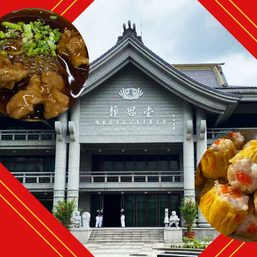
There are no comments yet. Add your comment to start the conversation.